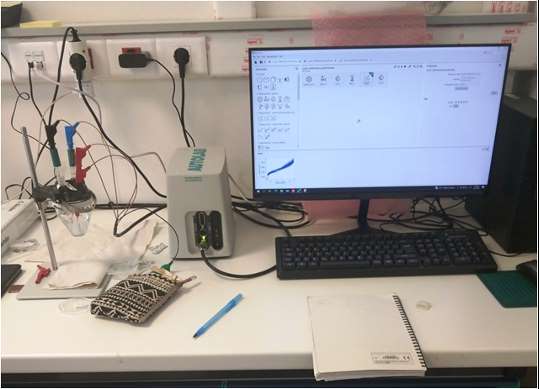Cyclic voltammetry and EIS
About
Cyclic voltammetry and electrochemical impedance spectroscopy (EIS) are vital techniques used in both making and assessing battery materials and devices. They help fabricate materials like graphene for battery electrodes by analyzing their electrochemical behavior, such as redox processes and ion intercalation. Additionally, they evaluate key battery parameters like capacity and stability, aiding in optimizing battery performance. These methods are essential for developing tailored energy storage solutions.
Description
-Cyclic voltammetry is an electrochemical technique used to study the redox behavior of the materials. It is consisted of a three-electrode set-up involving the reference electrode (Ag/AgCl), the counter electrode (Pt or graphite) and the working electrode (material under investigation). The system works by applying a potential to the WE, while measuring the resulting current. During this process, the redox reactions at the WE cause changes in the current, which are recorded as a function with the applied potential.
-Electrochemical impedance spectroscopy is impeded in the software of the cyclic voltammetry system. The impedance of the electrochemical cell, which is the ratio of the applied voltage to the resulting current, provides information about the resistance and capacitance of the cell. The data can be utilized to estimate the charge transfer kinetics of the electrolyte and electrode materials.
-Full battery cell – assemble full battery cell for the investigation of solid or gel samples in contact with electrodes. The cell is airtight and shielded against atmosphere. It can be used for moisture-sensitive samples.
Technical specifications:
Cyclic voltammetry with EIS – Potential range -10 V to 10 V, maximum current ± 0.4 A, number of current ranges remarks 10 nA to 100 mA, Potential and current accuracy V: ± 0.2% ± 2 mV and i: ± 0.2% ± 0.2% of current range, Potential resolution 3 µV (gain 100), current resolution 0.0003% of current range, maximum bandwidth 1 MHz, input impedance 100 GΩ.
Battery full cell-Supportive base, complete wiring for communication, and spring-loaded holders for separator, electrolyte and active material.
Case study:
An INFRACHIP user can analyze material redox behavior using Cyclic Voltammetry, gaining insights into electrochemical interactions crucial for battery performance. Integrated Electrochemical Impedance Spectroscopy further deepens understanding by assessing factors like charge transfer kinetics and electrolyte/electrode interactions. Additionally, assembling full battery cells in a controlled environment enables comprehensive testing of material performance, especially for moisture-sensitive samples, vital for battery development.
Access Provider / Facilities




